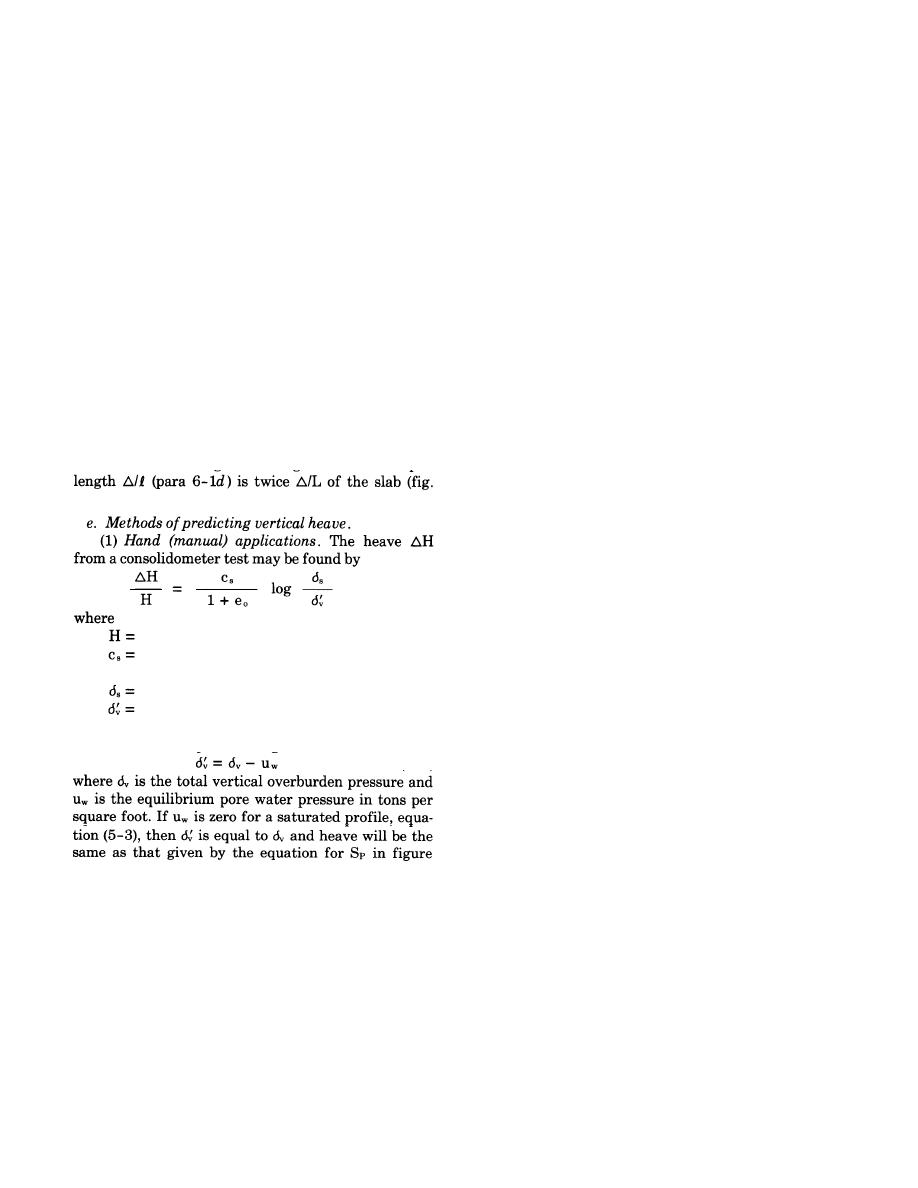
TM 5-818-7
Experiment Station. The program HEAVE is applica-
calculations require a measure or estimate of both sea-
ble to slab, long continuous, and circular shaft founda-
sonal wet and dry pore water pressure or suction pro-
tions. This program considers effects of loading and
files. It should be noted from figure 5-lb that perime-
soil overburden pressures on volume changes, hetero-
ter cyclic movement from extremes in climatic
geneous soils, and saturated or hydrostatic equilibri-
changes can exceed the long-term heave beneath the
um moisture profiles (equations (5-3) to (5-5)). Results
center of a structure.
of HEAVE using the saturated profile, equation (5-3),
(1) Soil-slab displacements. A slab constructed on
are comparable with results of manual computations
the ground surface of a wet site may in time lead to
described in figure 5-4.
downwarping at the edges after a long drought or
growth of a large tree near the structure (fig. 5-3a).
5-5. Potential differential heave
Edge uplift may occur following construction on an
Differential heave results from edge effects beneath a
initially dry site (fig. 5-3b). The AH in figure 5-3 is
finite covered area, drainage patterns, lateral varia-
representative of the maximum differential vertical
tions in thickness of the expansive foundation soil, and
heave beneath the slab, excluding effects of restraint
effects of occupancy. The shape and geometry of the
from the slab stiffness, but does consider the slab
structure also result in differential heave. Examples of
weight.
effects of occupancy include broken or leaking water
(2) Edge distance. The edge lift-off distance e of
lightly loaded thin slabs at the ground surface often
and sewer lines, watering of vegetation, and ponding
adjacent to the structure. Other causes of differential
varies from 2 to 6 feet but can reach 8 to 10 feet.
heave include differences in the distribution of load
(3) Deflection/length ratio. The deflection/length
ratio of the slab is A/L, where A is the slab deflection
and the size of footings.
and L is the slab length. The angular deflection/span
a. Unpredictability of variables. Reliable predic-
tions of future potential differential heave are often
5-3).
not possible because of many unpredictable variables
that include: future availability of moisture from
rainfall and other sources, uncertainty of the exact lo-
cations of heaving areas, and effects of human occu-
pancy.
(5-8)
b. Magnitude of differential heave.
(1) Potential differential heave can vary from zero
to as much as the total heave. Differential heave is of-
thickness of expansive soil layer, feet
swell index, slope of the curve between
ten equal to the estimated total heave for structures
supported on isolated spot footings or drilled shafts be-
points 3 and 4, figure 4-2
cause some footings or portions of slab foundations of-
swell pressure, tons per square foot
final vertical effective pressure, tons per
ten experience no movement. Eventually, differential
heave will approach the total heave for most practical
square foot
cases and should, therefore, be assumed equal to the
The final effective pressure is given by
total potential heave, unless local experience or other
(5-9)
information dictates otherwise.
(2) The maximum differential heave beneath a
lightly loaded foundation slab may also be estimated
by the procedure based on the moisture diffusion theo-
ry and soil classification data developed by the PTI.
Heave predictions by this method will tend to be less
4-2. A simple hand method and an example of predict-
ing potential total vertical heave from consolidometer
than by assuming that the differential heave is the to-
tal potential heave.
swell tests assuming a saturated equilibrium profile,
equation (5-3), are given in TM 5-818-1 and in figure
5-6. Heave with time
5-4. However, hand calculations of potential heave
Predictions of heave with time are rarely reliable be-
can become laborious, particularly in heterogeneous
cause the location and time when water is available to
profiles in which a variety of loading conditions need
the soil cannot be readily foreseen. Local experience
to be evaluated for several different designs,
has shown that most heave (and the associated struc-
(2) Computer applications. Predictions of poten-
tural distress) occurs within 5 to 8 years following con-
tial total heave or settlement can be made quickly with
struction, but the effects of heave may also not be ob-
the assistance of the computer program HEAVE avail-
served for many years until some change occurs in the
able at the U. S. Army Corps of Engineers Waterways
5-5


 Previous Page
Previous Page
